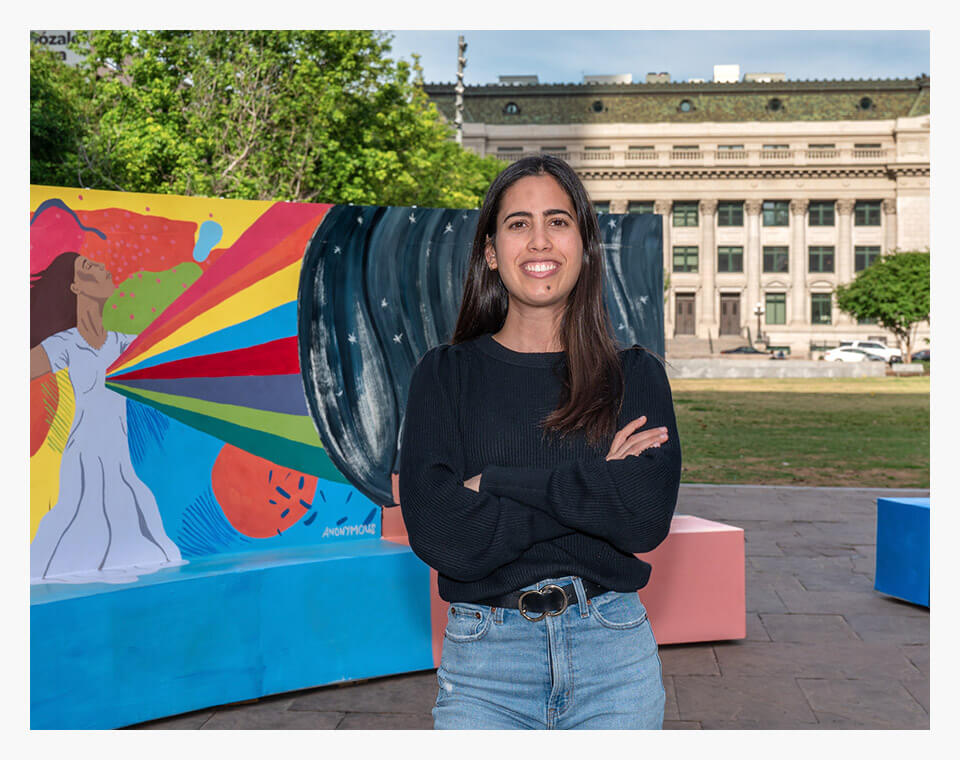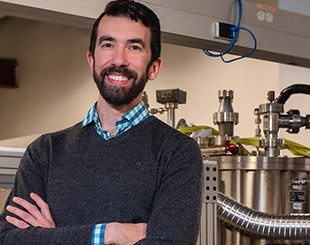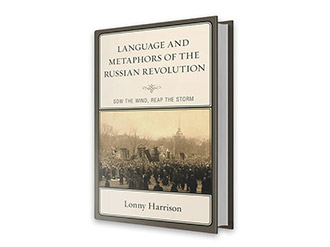The most meaningful class Angeles Margarida attended at The University of Texas at Arlington was in Tanzanian pastureland.
As part of a summer studio course in the College of Architecture, Planning, and Public Affairs (CAPPA), Margarida traveled with UTA classmates and faculty to the Tanzanian village of Roche to design a community garden. Determined to better know the local residents and understand their experiences, she accompanied several women on a hike to collect water needed for drinking, cleaning, and cooking in their homes.
The women balanced 5-gallon jugs on their heads with one hand and hauled 3-gallon jugs in the other, each container filled with murky pond water from nearby farmland. Margarida, a former collegiate soccer player, says she struggled to lug a single 3-gallon jug and keep up with the women on their 30-minute walk back to the village.
“They’re strong—those ladies can carry,” says Margarida, who graduated in May 2021 with a master’s in landscape architecture. “Listening to people who come from different backgrounds, life experiences, and cultures and providing a design that is tailored to them and will benefit their community? That felt like a very authentic experience to me.”
That sense of service to a greater cause, in tandem with powerful educational experiences that help Maverick students on their paths to their degrees, forge the backbone of the Center for Service Learning (CSL), one of the key programs under UTA’s Center for Research on Teaching and Learning Excellence.
Celebrating its 20th anniversary at UTA, the CSL works with faculty members to integrate community service into academic coursework, a union that promotes both civic responsibility and the advancement of students’ educational and career goals.
“Service learning allows students to experience the power of collaboration with community partners through their coursework,” says Susan Dequeant, director of the CSL. “Students get real-world experiences and richer, better-rounded learning processes.”
At UTA, service learning also fits into the Maverick Advantage program, which provides opportunities for UTA students to distinguish themselves through experiential learning opportunities both inside and outside the classroom. Service learning can take many forms at UT Arlington. Public health students have created campuswide anti-smoking events in partnership with Human Resources. Broadcast communications students develop promotional videos for area nonprofits. Landscape architecture students have worked with municipalities to protect coastal islands from floating garbage. Communication technology students build websites for fledgling community groups.
Regardless of the project, the community becomes an important part of the curriculum. Moreover, the lessons can be local or global.
“One of the great things about service learning is that it allows students to put their skills to the test,” says Diane Jones Allen, CAPPA professor and director of UTA’s Landscape Architecture program. “Students learn how to be creative for someone else, to really serve others.”
That sense of service is an element that Rebecca Garner, clinical associate professor in the College of Nursing and Health Innovation (CONHI), tries to instill in her Introduction to Public Health course. She says her students need opportunities to apply their lessons in the real world.
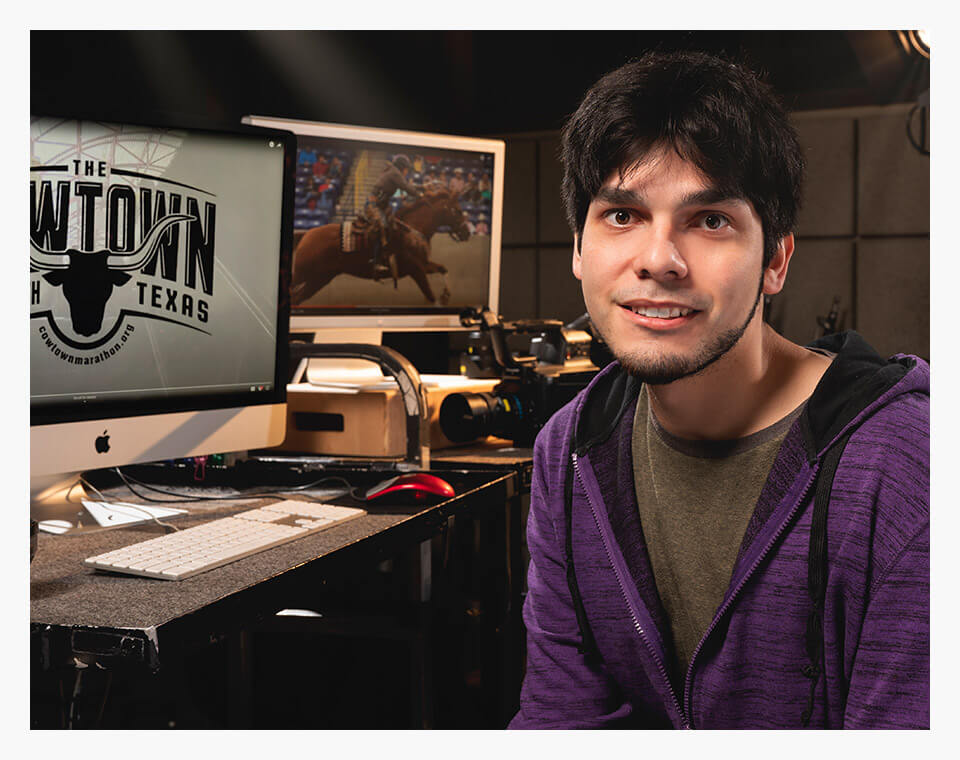
Michael Costilla worked on a project to celebrate a hometown hero running the Cowtown Marathon in Fort Worth.
“Public health is a person-centered field,” says Dr. Garner, who is also director of CONHI’s undergraduate public health program. “Students need to practice the skills they’re learning in the classrooms.”
Garner’s students partnered with UTA Health Services and the Office of Human Resources on anti-smoking campaigns. They created one-hour seminars, interactive educational exhibits, and even a large-scale campus event called “Smoke This, Not That” that gave free Texas barbecue to Mavericks who viewed their smoking-cessation displays.
She says the key benefits to service learning are participation in community service, forcing students outside of their comfort zones, and providing students with opportunities to learn in different ways.
For students preparing to enter the workforce, a fourth benefit may be the most practical: a chance to gain professional experience and build one’s resume or portfolio in the process.
That was certainly true for Michael Costilla, whose most meaningful UTA class may have been race day at The Cowtown Marathon in Fort Worth. As a student in a corporate video course taught by LaDonna Aiken, broadcast specialist in the Department of Communication, Costilla found himself working on a video project for the marathon with several classmates.
Their job was to film a “hometown heroes” promotional video featuring a well-known horse trainer. Their only problem: On race day, they didn’t know what the horse trainer was wearing and how they would find her amid tens of thousands of other runners.
“We needed a Plan B,” says Costilla, who graduated in 2020 with a degree in broadcast communications from the College of Liberal Arts.
The video team members fanned out across the course to ensure they wouldn’t miss her, but they weren’t certain they captured the needed footage. Only later when he was editing did Costilla realize he had the shots he needed. “The best feeling in the world,” he says.
Aiken provides her corporate video students with similar opportunities through a variety of area nonprofits and government entities. Her students have made promotional videos for the Texas Girls’ Choir, city of Arlington, city of Grand Prairie, Red Balloon Network, Mission Arlington, and more.
“Working with outside organizations nurtures that intrinsic motivation that students might not always have for regular class work,” Aiken says. “It opens up possibilities of what they could do in the future with their work and gives them a sense of confidence to say, ‘I can do this. I am making a difference.’”
Costilla, who got his start as the only member of his high school’s audio-visual club, says he still lands jobs as a freelance videographer thanks to the portfolio he built through service-learning projects.
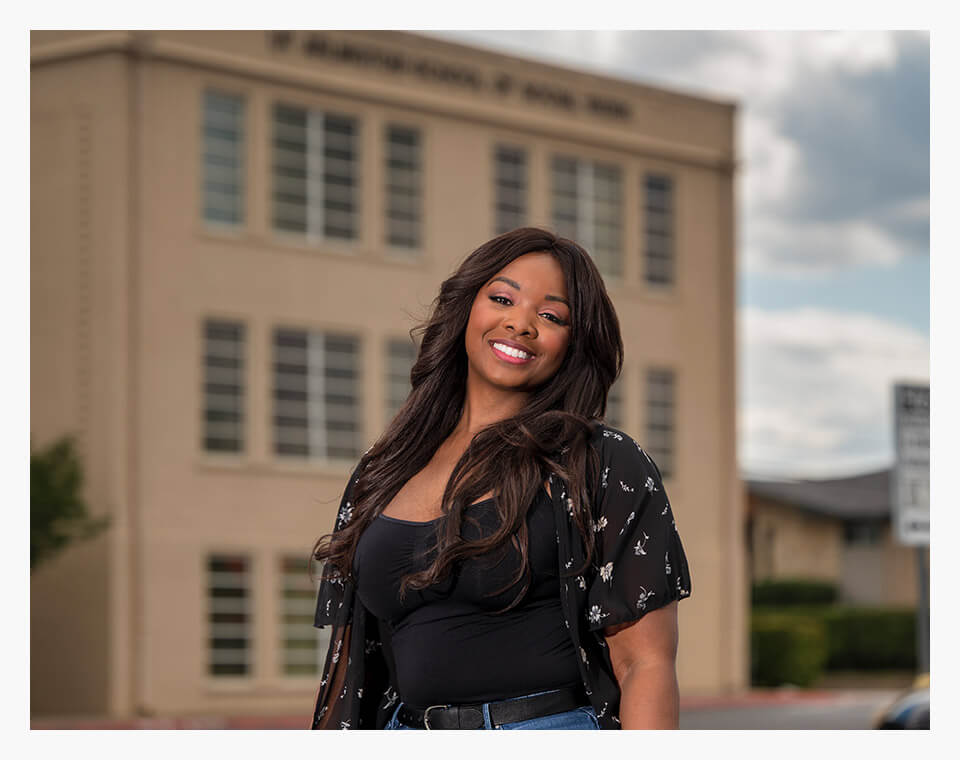
Jami Walton, now pursuing a master’s in social work at UTA, says her service-learning course informed her current career path.
“You can learn all the theory you want, but the hands-on experience is incredibly valuable,” he says. “If you are actually there, practicing what you have been learning, you are going to remember that. You will remember the struggles you faced. You will remember the fun that you had. It’s all about the experience.”
Starr Robinson, a communications technology senior, says one of her most valuable UTA classroom experiences has been building a website for a new organization that helps individuals who were wrongly convicted, like the organization’s founder. She says the pressure of doing right by her client far exceeds the pressure of any other assignment.
“My jaw dropped when the founder told us her story,” Robinson says. “I want to make sure this is pretty much perfect. We have to give it our all.”
Jami Walton’s experience with service learning was so valuable that it led directly to a job. In 2017, she was a student in an Introduction to Social Work course taught by Jim Langford, associate professor in practice in the School of Social Work. Dr. Langford’s course required 20 hours of volunteering at the Salvation Army.
Walton draws a straight line from that class to her former job as program manager at the Salvation Army in Arlington.
“If it weren’t for the service-learning experience, I wouldn’t be where I am,” Walton says. “Professor Langford sparked the light that set me on the path to where I am now.”
The organization soon hired her as a shelter monitor, then later promoted her to case management specialist and then again to program manager, where she oversaw operations for the homeless shelter, the kitchen staff, the cold weather shelter, and the community food pantry.
Walton, who graduated with a Bachelor of Social Work in 2019, fulfilled her commitment while finding her calling.
Service learning allows students to experience the power of collaboration with community partners through their coursework.
“To the people who walked through the doors of our shelter, I know I will forever be a part of their success stories,” says Walton, who is now working on her Master of Social Work at UTA. “I wanted to help them become something that they don’t see in themselves. I wanted them to know the shelter wasn’t their final destiny.”
Margarida says her trip to Tanzania had a similar life-changing impact, even inspiring and informing her thesis project: “Empowering Artists Experiencing Homelessness Through Temporary Public Art in the City of Dallas.” She is working with individuals who are experiencing homelessness to create a temporary art exhibit featuring murals that address their stories. The murals will be on display in Main Street Garden Park in downtown Dallas.
She says she also hopes to find work at a firm that engages closely with community members on its projects. She traces this desire back to a muddy pond, a group of powerful, intrepid women, and a rewarding project that helped improve the quality of life in a Tanzanian village.
“Without that trip, it might have been a different thesis,” Margarida says. “I never had the experience before of engaging with a community like that. I never would have known how much I enjoyed this type of work.”uta
